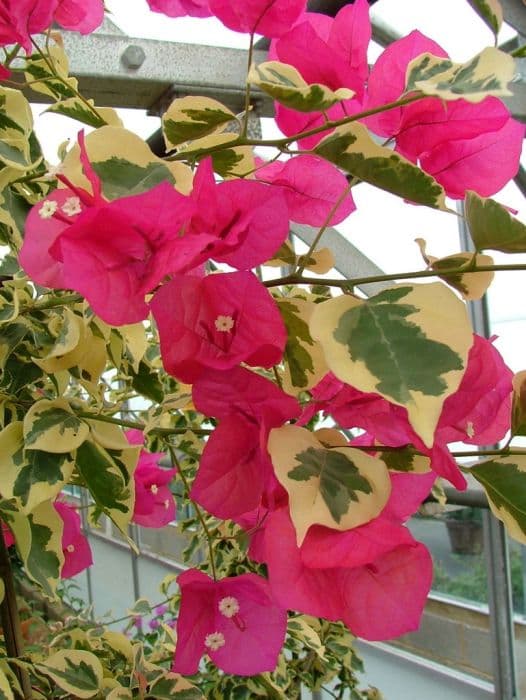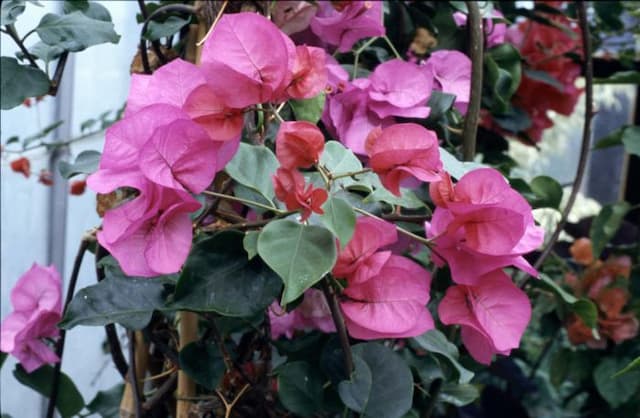Raspberry Ice Bougainvillea Bougainvillea × buttiana 'Raspberry Ice' (v)

ABOUT
The Bougainvillea 'Raspberry Ice' is a vibrant, colorful plant known for its striking appearance. It boasts a prolific display of raspberry-pink bracts, which are specialized leaves that surround the plant's small, white flowers. These bracts are the most eye-catching aspect of the plant, often mistaken for petals due to their bright color and abundance. The bracts emerge periodically throughout the year, especially in warmer seasons, providing a long-lasting splash of color in the garden. Accompanying the vivid bracts are the plant's leaves, which are equally distinctive. They have a variegated pattern, blending a creamy-yellow to white margin with a deep green center, giving a striking contrast against the pink hues. This variegation adds another layer of visual interest and makes 'Raspberry Ice' a popular choice among gardeners looking to add a touch of vibrancy to their landscapes. The plant itself has a sprawling habit, with stems that may be adorned with thorns. These thorns, while sharp, are typically hidden beneath the lush foliage and spectacular floral display. The Bougainvillea 'Raspberry Ice' is a truly magnificent specimen, celebrated for its extraordinary color combination and dramatic presence, making it a favorite in warm-climate gardens.
About this plant
 Names
NamesFamily
Nyctaginaceae
Synonyms
Paper Flower, Lesser Bougainvillea, Raspberry Ice Bougainvillea
Common names
Bougainvillea × buttiana 'Raspberry Ice'.
 Toxicity
ToxicityTo humans
Bougainvillea is not considered highly toxic to humans. However, ingestion of its parts, particularly the leaves and flowers, can cause mild gastrointestinal discomfort, including nausea, vomiting, or diarrhea. Additionally, the plant's sap can cause skin irritation or allergic reactions in some individuals. If one experiences severe symptoms after ingesting or contact with Bougainvillea, medical consultation is advised.
To pets
Bougainvillea is also not considered highly toxic to pets. Ingestion of the plant may result in gastrointestinal upset for cats and dogs, such as vomiting or diarrhea. As with humans, the sap may cause skin irritation on contact. If a pet consumes a large amount of Bougainvillea or shows signs of distress, it is recommended to seek veterinary care.
 Characteristics
CharacteristicsLife cycle
Perennials
Foliage type
Evergreen
Color of leaves
Variegated
Flower color
Raspberry
Height
1-2 feet (0.3-0.6 meters)
Spread
3-4 feet (0.9-1.2 meters)
Plant type
Shrub
Hardiness zones
9-11
Native area
South America
Benefits
 General Benefits
General Benefits- Attractive Foliage - 'Raspberry Ice' bougainvillea has variegated green and cream leaves that are attractive even when the plant is not in bloom.
- Vivid Blooms - It produces vibrant pink flower bracts that add a splash of color to any landscape.
- Drought Tolerance - Once established, this bougainvillea is highly tolerant of drought conditions, making it suitable for xeriscaping.
- Low Maintenance - Requires minimal care once it has become established in a suitable location, with only occasional pruning and watering.
- Heat Resistance - Thrives in hot climates where many other plants might struggle, making it ideal for warm regions.
- Pest Resistance - Generally resistant to pests, reducing the need for chemical pest control.
- Long Blooming Period - Offers prolonged periods of blooming throughout the warmer months, providing long-lasting visual interest.
- Versatility - Can be grown as a shrub, vine, or ground cover, making it a versatile choice for a variety of garden designs.
- Privacy Screen - When trained on trellises or fences, it can provide a dense screen for privacy or to mask unsightly areas.
- Soil Adaptability - Adapts to a wide range of soil types, although it prefers well-drained soil.
 Medical Properties
Medical PropertiesThis plant is not used for medical purposes.
 Air-purifying Qualities
Air-purifying QualitiesThis plant is not specifically known for air purifying qualities.
 Other Uses
Other Uses- Bonsai: Bougainvillea can be trained as a bonsai plant, providing miniature landscape scenes for botanical enthusiasts and artistic displays.
- Topiary: The vigorous growth habit of bougainvillea allows it to be sculpted into various shapes when supported by a frame, making it ideal for topiary art.
- Culinary Garnish: Although not commonly known for culinary use, bougainvillea flowers can be used to garnish salads or desserts for an exotic touch, provided they have not been treated with pesticides.
- Natural Dye: The bracts of bougainvillea can be used to produce natural dyes for fabric, offering a range of colors from pink to magenta.
- Barrier Planting: Due to its thorny nature, bougainvillea can be planted to create living barriers or fences that deter trespassers and large animals.
- Ink Production: Similar to its use in dyes, bougainvillea bracts can be boiled down to produce natural inks for artistic or writing purposes.
- Photography Prop: Bougainvillea's vibrant colors and lush appearance make it a popular backdrop in outdoor photography, lending a tropical feel to images.
- Erosion Control: Bougainvillea can be used in erosion control by stabilizing steep slopes with its extensive root system.
- Craft Material: The woody stems of mature plants can be used to make small craft items or as a natural element in floral arrangements.
- Livestock Feed: In some regions, the leaves of bougainvillea are occasionally used as fodder for livestock, although it is not a common practice due to the plant's low nutritional value.
Interesting Facts
 Feng Shui
Feng ShuiBougainvillea is often used in Feng Shui for its vibrant energy, which is believed to enhance wealth and good fortune. It can be used in the South area of a garden or space to attract fame and recognition or in the Southeast to boost prosperity.
 Zodiac Sign Compitability
Zodiac Sign CompitabilityThe Bougainvillea is not used in astrology practice.
 Plant Symbolism
Plant Symbolism- Passion: Bougainvillea often symbolizes passion due to its vibrant and intense colors, reflecting strong emotions and a zest for life.
- Beauty: The striking appearance of Bougainvillea, with its bright bracts and contrasting foliage, represents beauty and splendor.
- Warmth: Native to tropical regions, the plant is commonly associated with warm climates and, by extension, the warmth of hospitality and welcome.
- Survival: Bougainvillea is known for its resilience and ability to thrive in harsh conditions, making it symbolic of tenacity and the will to survive and prosper.
- Protection: The plant's thick, thorny vines can form a natural barrier, symbolizing protection and a safe haven.
 Water
WaterBougainvilleas should be watered deeply once the top inch of soil feels dry to the touch, typically this might be once a week during the growing season. In cooler periods or when dormant, water less frequently, enforcing a period of dryness between waterings to mimic its native environment. Established plants can tolerate some drought, but consistent under-watering can stress the plant. When watering, soak the soil around the root zone with about 1-2 gallons for medium-sized plants, avoiding light, frequent sprinklings which can lead to shallow roots and weaker plants.
 Light
LightBougainvillea prefers full sun for best bloom and growth, requiring at least six hours of direct sunlight per day. An ideal spot would be a south-facing area, where they can bask in unfiltered light most of the day. If grown indoors, a spot near a large sunny window or a sunroom would be best to ensure the plant receives sufficient light.
 Temperature
TemperatureBougainvilleas thrive in warm conditions and should be kept in temperatures above 40 degrees Fahrenheit to avoid damage. They perform best when daytime temperatures are between 70 and 85 degrees Fahrenheit and night temperatures do not drop below 60 degrees Fahrenheit. These plants can endure short periods of cooler weather, but prolonged exposure to temperatures below freezing may kill the plant.
 Pruning
PruningPruning stimulates new growth and flowering in bougainvilleas and should be done immediately after the plant finishes a blooming cycle. Lightly trim the plant to shape it and remove any dead wood or spindly growth. Major pruning should be done in early spring, cutting back to about one-third to encourage lush new growth and plenty of flowers for the upcoming season.
 Cleaning
CleaningAs needed
 Soil
SoilBougainvillea 'Raspberry Ice' prefers a well-draining and fertile soil mix with a pH between 5.5 and 6.0. An ideal mixture can be made with equal parts peat, pine bark, and coarse sand or perlite to enhance drainage. Regular fertilization during the growing season will benefit its blooming and growth.
 Repotting
RepottingBougainvillea 'Raspberry Ice' should be repotted every 2-3 years or when it has outgrown its current pot. It is best to repot in the spring or early summer, which allows the plant to recover and establish in the warmer months before winter.
 Humidity & Misting
Humidity & MistingBougainvillea 'Raspberry Ice' tolerates a wide range of humidity levels but thrives best in moderate to high humidity. However, it will do well in typical outdoor conditions where the humidity is not artificially regulated.
 Suitable locations
Suitable locationsIndoor
Ensure full sun, well-drained soil, and warm temperatures.
Outdoor
Place in full sun, use well-draining soil, and protect from frost.
Hardiness zone
9b-11 USDA
 Life cycle
Life cycleThe life cycle of the 'Raspberry Ice' Bougainvillea begins with seed germination, where under suitable conditions, seeds will sprout and establish a root system. As a seedling, the plant starts to grow vigorously, developing foliage and a strong stem. Mature Bougainvillea 'Raspberry Ice' transitions to a vegetative stage characterized by dense, green foliage edged in creamy white and vigorous vine growth. Following the vegetative phase, it enters the blooming stage, where the plant produces vibrant pinkish-red bracts that surround the small, inconspicuous flowers, typically peaking in warmer months. After pollination, the plant may produce seeds, completing the reproductive cycle, although 'Raspberry Ice' is often propagated through cuttings rather than grown from seed. Finally, in perennial growth zones, 'Raspberry Ice' enters a period of dormancy during cooler months before resuming active growth and blooming in the following season.
 Propogation
PropogationPropogation time
Spring-Early Summer
The most popular method of propagating Bougainvillea × buttiana 'Raspberry Ice' is through stem cuttings, which is often done during the late spring or early summer when the plant is in active growth. To do this, a healthy, semi-hardwood stem around 4 to 6 inches (10 to 15 centimeters) long is cut from the plant. The cutting should have several sets of leaves, but the lower sets are removed to expose nodes where new roots will form. The cut end is often dipped in rooting hormone powder to encourage root growth and then planted in a well-draining soil mix or potting medium. The container with the cutting should be kept warm, around 75 degrees Fahrenheit (24 degrees Celsius), and the soil should be maintained just damp, but not waterlogged, to prevent rot. It usually takes a few weeks for cuttings to root sufficiently to be gradually acclimatized to outdoor conditions before being replanted in their final location.

![Bougainvillea [Camarillo Fiesta]](/_next/image?url=https%3A%2F%2Fplants-admin.emdemapps.com%2Fimages%2Fplants%2F%2Fimages%2F604b5ce2e4016.png&w=640&q=75)


